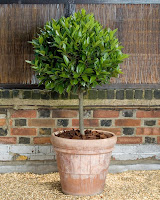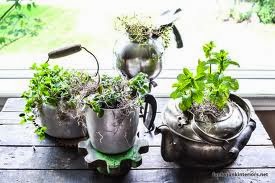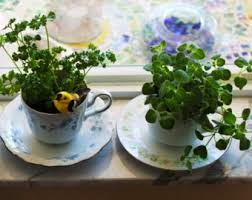 Many herbs—including oregano, thyme, rosemary, and sage—are
easy to grow indoors just by taking a cutting from an existing outdoor
plant. You can grow herbs indoors this winter and add that fresh just
-picked taste to your meals. Growing herbs indoors is easy you don't even
need special lights just a bright window.
Many herbs—including oregano, thyme, rosemary, and sage—are
easy to grow indoors just by taking a cutting from an existing outdoor
plant. You can grow herbs indoors this winter and add that fresh just
-picked taste to your meals. Growing herbs indoors is easy you don't even
need special lights just a bright window.
Techniques
for Growing Herbs Indoors
Rooting
a cutting
Snip off a 4-inch section, measured back from the tip. Strip off the lower leaves and stick the stem into moist, soilless mix, such as perlite and/or vermiculite. Cover with glass or clear plastic to add humidity and keep the growing medium-moist.
Snip off a 4-inch section, measured back from the tip. Strip off the lower leaves and stick the stem into moist, soilless mix, such as perlite and/or vermiculite. Cover with glass or clear plastic to add humidity and keep the growing medium-moist.
Transition
to indoors
Before the first fall frost start moving your potted herb
plants toward their winter home. Instead of bringing them directly inside, put
them in a bright, cool "transitional zone," such as a garage,
entryway, or enclosed porch, for a few weeks.
Once they've acclimated, move them to an area with lots of
sun (south-facing windows are brightest, followed by east or west views). But
protect them from heat and dryness. Most herbs prefer daytime temperatures of
about 65 to 70 degrees F, although they can withstand climbs into the 70s. It's
especially important that night temperatures drop at least 10 degrees—down into
the 50s would be better—to simulate outdoor conditions.
Here
are the best herbs for growing on windowsills and the smart techniques you need
to keep them happy and healthy until you can plant outside again.
 Basil: Start basil from
seeds and place the pots in a south-facing window—it likes lots of sun and
warmth.
Basil: Start basil from
seeds and place the pots in a south-facing window—it likes lots of sun and
warmth. Bay: A
perennial that grows well in containers all year long. Place the pot in an
east, or west, facing window, but be sure it does not get crowded—bay needs air
circulation to remain healthy.
Bay: A
perennial that grows well in containers all year long. Place the pot in an
east, or west, facing window, but be sure it does not get crowded—bay needs air
circulation to remain healthy. Chervil: Start
chervil seeds in late summer. It grows well in low light but needs 65 to 70
degrees F temperatures to thrive.
Chervil: Start
chervil seeds in late summer. It grows well in low light but needs 65 to 70
degrees F temperatures to thrive. Chives: Dig
up a clump from your garden at the end of the growing season and pot it up.
Leave the pot outside until the leaves die back. In early winter, move the pot
to your coolest indoor spot (such as a basement) for a few days, then finally
to your brightest window.
Chives: Dig
up a clump from your garden at the end of the growing season and pot it up.
Leave the pot outside until the leaves die back. In early winter, move the pot
to your coolest indoor spot (such as a basement) for a few days, then finally
to your brightest window. Oregano: Your
best bet is to start with a tip cutting from an outdoor plant. Place the pot in
a south-facing window.
Oregano: Your
best bet is to start with a tip cutting from an outdoor plant. Place the pot in
a south-facing window.
You
can start this herb from seeds or dig up a clump from your garden at the end of
the season. Parsley likes full sun, but will grow slowly in an east, or west,
facing window.
Start
with a cutting of rosemary, and keep it in moist soilless mix until it roots.
It grows best in a south-facing window.
 Sage: Take
a tip cutting from an outdoor plant to start an indoor sage. It tolerates dry,
indoor air well, but it needs the strong sun it will get in a south-facing
window.
Sage: Take
a tip cutting from an outdoor plant to start an indoor sage. It tolerates dry,
indoor air well, but it needs the strong sun it will get in a south-facing
window.
Tarragon: A
dormant period in late fall or early winter is essential for tarragon to grow
indoors. Pot up a mature plant from your outdoor garden and leave it outside
until the leaves die back. Bring it to your coolest indoor spot for a few days,
then place it in a south-facing window for as much sun as possible. Feed well
with an organic liquid fertilizer.
Tags: herb, herbs, ten best herbs, grow indoors, plant, flowers, edible, basil, thyme, chives



No comments:
Post a Comment
Please leave a comment or ask a gardening question.